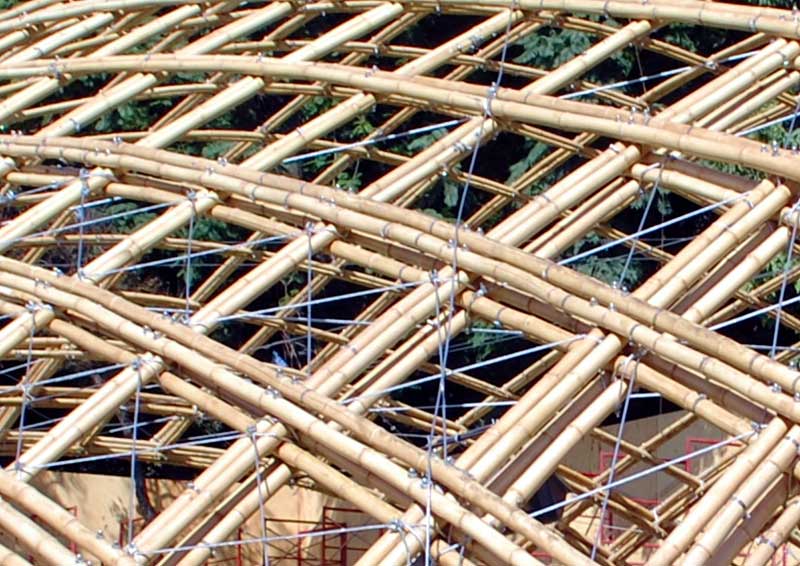Bamboo
Natural organic materials such as bamboo have a very important and unique role in the effort to alleviate housing and infrastructure problems, particularly in developing countries. Their use is of a special relevance in the context of widespread damage and destruction caused by natural disasters owing to global warming, which in part is attributed to the vast use of polluting and high-energy-demanding materials, such as steel and cement.
Although bamboo has been identified as the most promising building material for decades; technical, normative and cultural challenges have prevented its widespread use in construction.
However, after almost four decades of systematic research and development into bamboo, there is sufficient scientific information to increase the use of bamboo as a substitute for the industrial and polluting materials in many applications of the construction industry.
Bamboo grows in abundance in many parts of the world, especially in tropical and subtropical regions. Bamboo forests play an important role in controlling water cycles, reducing erosion and sequestering carbon from the atmosphere.
The culms of four to five years of age can be effectively used in construction and other engineering products. An increased use of bamboo does not pose a risk for bamboo forests; on the contrary, it will create economic incentives for farmers to develop bamboo plantations and use the bamboo shoots for their everyday lives.
An increase in the use of bamboo in construction could lead to energy savings, conservation of the world's scarce resources and reduction in environmental pollution. Bamboo forests are the most easily available resources for many communities, which can be used to solve housing problems. This is also a challenge to the science and skills of engineers accustomed to using well developed technologies.
Even though bamboo is a fast-growing, high-yielding and easily renewable natural resource, the ability of engineers to use it in durable construction requires more research and development.
The structural efficiency of bamboo compared to that of other engineering materials such as steel has been shown, which may be attributed to the high strength of the uniaxial reinforcing fibres and the hollow cylindrical shape of the culm. However, these characteristics along with the geometrical irregularities of the raw material pose challenges to develop efficient and cost-effective structural joints.
In addition, the major factors facing the development of durable bamboo constructions are the inherent weaknesses of the material, such as high water absorption and susceptibility to fungal and insect attack. Bamboo contains hemicelluloses, starch, sugar, tannins, certain phenols and lignin, which can be attacked by soluble extractives, preventing it from having a good durability characteristic.
Following years of research and development since the 1970s in South America, there is sufficient scientific information to increment the use of bamboo as a substitute for steel in many applications. Studies using timber test methods have shown that outdoor laminated bamboo has properties comparable to timber and glue-laminated timber.
This article was originally published here on 30 Mar 2017 by ICE. It was written by Khosrow Ghavami and José Jaime García.
--The Institution of Civil Engineers
[edit] Related articles on Designing Buildings Wiki
Featured articles and news
Latest Build UK Building Safety Regime explainer published
Key elements in one short, now updated document.
UKGBC launch the UK Climate Resilience Roadmap
First guidance of its kind on direct climate impacts for the built environment and how it can adapt.
CLC Health, Safety and Wellbeing Strategy 2025
Launched by the Minister for Industry to look at fatalities on site, improving mental health and other issues.
One of the most impressive Victorian architects. Book review.
Common Assessment Standard now with building safety
New CAS update now includes mandatory building safety questions.
RTPI leader to become new CIOB Chief Executive Officer
Dr Victoria Hills MRTPI, FICE to take over after Caroline Gumble’s departure.
Social and affordable housing, a long term plan for delivery
The “Delivering a Decade of Renewal for Social and Affordable Housing” strategy sets out future path.
A change to adoptive architecture
Effects of global weather warming on architectural detailing, material choice and human interaction.
The proposed publicly owned and backed subsidiary of Homes England, to facilitate new homes.
How big is the problem and what can we do to mitigate the effects?
Overheating guidance and tools for building designers
A number of cool guides to help with the heat.
The UK's Modern Industrial Strategy: A 10 year plan
Previous consultation criticism, current key elements and general support with some persisting reservations.
Building Safety Regulator reforms
New roles, new staff and a new fast track service pave the way for a single construction regulator.
Architectural Technologist CPDs and Communications
CIAT CPD… and how you can do it!
Cooling centres and cool spaces
Managing extreme heat in cities by directing the public to places for heat stress relief and water sources.
Winter gardens: A brief history and warm variations
Extending the season with glass in different forms and terms.
Restoring Great Yarmouth's Winter Gardens
Transforming one of the least sustainable constructions imaginable.
























